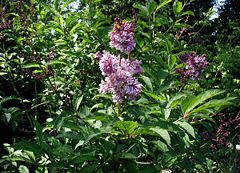Syringa josikaea
| Habit | shrub
| |
|---|---|---|
| Height: | ⇕ | 12 ft"ft" can not be assigned to a declared number type with value 12. |
| Width: | ⇔ | 10 ft"ft" can not be assigned to a declared number type with value 10. |
| Lifespan: | ⌛ | perennial |
| Exposure: | ☼ | sun |
|---|---|---|
| USDA Zones: | 5 to 9 | |
| Flower features: | ❀ | blue, purple |
|
Oleaceae > |
Syringa > |
josikaea > |
Syringa josikaea (Hungarian Lilac) is a species of Lilac, native to central and eastern Europe, in the Carpathian Mountains in Hungary, Romania, and western Ukraine.[1][2]
It is a deciduous shrub growing to a height of 2-4 m. The leaves are elliptic-acute, 6–12 cm long, with a finely hairy margin. The flowers are dark pink, with a tubular base to the corolla 15 mm long with a narrow four-lobed apex 3–4 mm across, with a strong fragrance; they are produced in slender panicles up to 15 cm long in early summer. The fruit is a dry, smooth brown capsule, splitting in two to release the two winged seeds.[1][3][4]
Read about Syringa josikaea in the Standard Cyclopedia of Horticulture
|
|---|
|
Syringa josikaea, Jacq. Shrub, attaining 12 ft., with upright, stout, terete branches: lvs. broadly elliptic to elliptic-oblong, acute at both ends, finely ciliate, dark green and shining above, glabrous or pubescent on the midrib beneath, 2 1/2 - 5 in. long: fls. violet, short-pedicelled or almost sessile, clustered, in rather narrow panicles 3-7 in. long; corolla with the half-upright lobes 3/4 in. long; stamens inserted somewhat above the middle of the tube. June. Hungary.— Less handsome than most other species, but valuable for its late blooming season. Var. pallida, Hort., has pale violet fls.; var. rubra, Hort., reddish violet fls. CH
|
Cultivation
Growing conditions allow for cool to temperate climate and are fully frost hardy. The plant also grows in full sun to semi shade.[4] Despite its continental European origin, it has proved to be surprisingly successful when cultivated in the oceanic extremes of northwestern Europe on the Faroe Islands and in arctic northern Norway north to Kirkenes.[5]
Propagation
Pests and diseases
Varieties
It has hybridised in cultivation with the closely related Syringa komarowii from China; the hybrid is named Syringa × josiflexa.[3]
Gallery
References
- ↑ 1.0 1.1 Rushforth, K. (1999). Trees of Britain and Europe. Collins ISBN 0-00-220013-9.
- ↑ Flora Europaea: Syringa josikaea
- ↑ 3.0 3.1 Huxley, A., ed. (1992). New RHS Dictionary of Gardening. Macmillan ISBN 0-333-47494-5.
- ↑ 4.0 4.1 Plants for a Future: Syringa josikaea
- ↑ Højgaard, A., Jóhansen, J., & Ødum, S. (1989). A century of tree planting on the Faroe Islands. Ann. Soc. Sci. Faeroensis Supplementum 14.
External links
- w:Syringa josikaea. Some of the material on this page may be from Wikipedia, under the Creative Commons license.
- Syringa josikaea QR Code (Size 50, 100, 200, 500)


